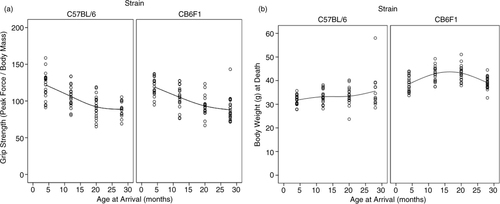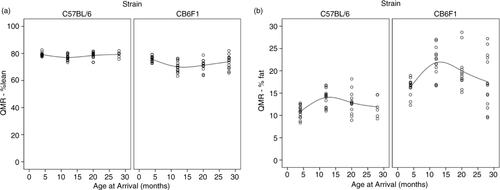Figures & data
Fig. 1 (a) B6 mouse paw strength declined from 121.8±18.5 to 106.2±15.1 to 92.1±15.7 to 88.6±10.9 from ages 4, 12, 20, and 28 months, respectively. Following the same pattern, CB6F1 mouse grip strength declined from 119.2±12.3 to 105.0±15.7 to 93.2±14.0 to 87.9±16.0 through the four age groups. (b) B6 mice had average masses of 31.75±2.1, 33.19±2.19, 33.40±3.73, and 35.60±7.59 g at the 4, 12, 20, and 28 months of age, respectively. CB6F1 mice had increased body weights in the 12- and 20-month age groups compared to 4- and 28-month age groups. The B6 mice had mean masses of 38.57±3.24, 42.93±3.29, 43.19±3.27, and 39.09±2.54 g at 4, 12, 20, and 28 months of age, respectively. Strain, age groups, and the interaction between strain and age were all significant (p<0.001, p=0.001, p=0.001, respectively).

Fig. 2 (a) B6 mice at 4, 12, 20, and 28 months of age had mean lean mass percentages of 79.0±1.4, 77.0±2.1, 78.8±2.4, and 79.4±2.0, respectively. CB6F1 mice at 4, 12, 20, and 28 months of age had mean lean mass percentages of 75.8±2.1, 70.2±3.8, 69.7±5.2, and 74.1±4.7, respectively. (b) B6 mice at 4, 12 20, and 28 months of age had mean percent fat masses of 11.1±1.6, 14.1±1.8, 12.7±2.4, and 11.8±2.1, respectively. CB6F1 mice at 4, 12, 20, and 28 months of age had mean percent fat masses of 16.3±1.7, 21.9±3.3, 21.6±5.2, and 17.3±5.7, respectively.


